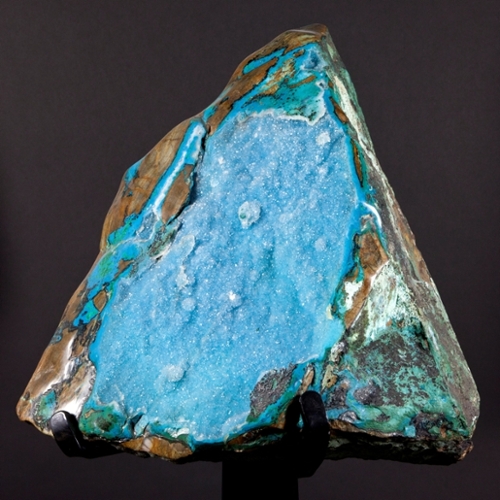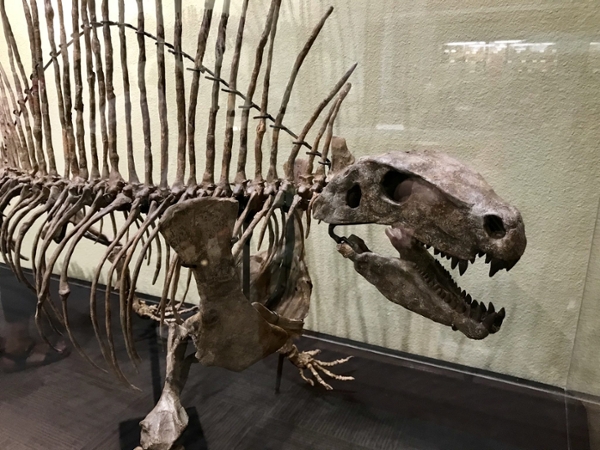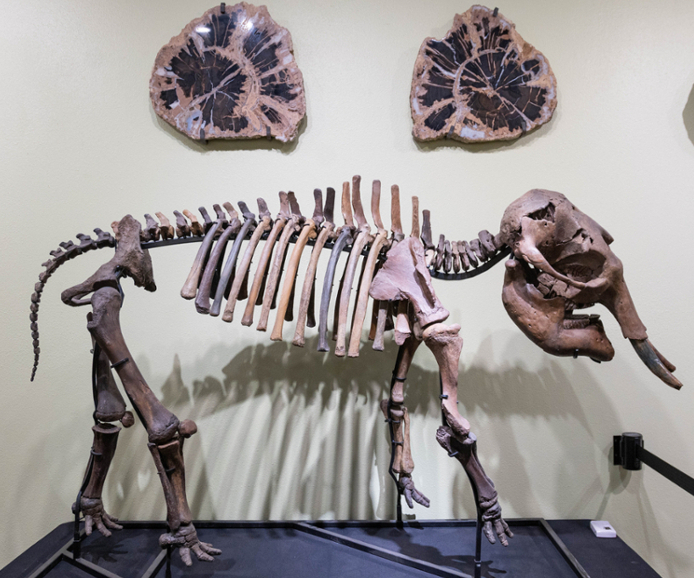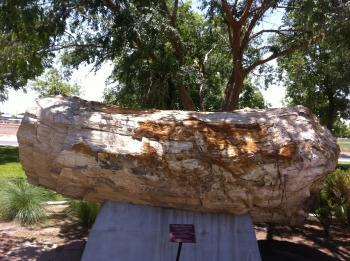Chrysocolla

This is the finest and most spectacular specimen of gem Chrysocolla ever found at the Ray Mine in Arizona, which was world famous for some of the finest gem chrysocolla, specimens in the world. Gem Chrysocolla is in the same family as turquoise.
There is a clear coating of hundreds of tiny glass clear quartz crystals covering the blue green chrysocolla which gives a luster and visual brilliance to the piece.
This crystal formation is considered one of the greatest specimens of druzy (covered with tiny quartz crystals) Chrysocolla ever discovered anywhere in the world and is a major world class treasure.
“Zoli”
Dimetrodon Fossilized Skeleton

Dimetrodon milleri
Age: Early Permian, Wolfcampian (299-280 MYA)
Found: Moran Formation in Archer County, Texas, USA
Measures: 35 inches tall and 60 inches long
This complete skeleton of Dimetrodon is as interesting and intriguing as it looks. The primitive non-mammalian synapsid (meaning one opening in the side of the skull) belonged to the group known as pelycosaurs. The prominent “sail” consisting of elongated vertebral spines is the most recognizable feature of this ancient beast.
Pelycosaurs dominated the prehistoric landscape for some 40 million years. They are more closely related to modern mammals than reptiles. Dimetrodon was the apex predator of its day along the lines of Megalodon and Tyrannosaurus rex – and lived an unbelievable ~100 million years before the Dinosaurs!
Dimetrodon milleri is the oldest, and among the smallest, of the known species.
“Zoli” came out of the vaulted Texas Red Beds of the Permian Basin. This fossil consists of approximately 95% real fossilized bone, composited from animals in nearby localities, but is “built” around a 40% associated creature.
“Borealis”
Baby Woolly Mammoth Fossilized Skeleton

Mammuthus primigenius
Age: Pleistocene Epoch (2.6 MYA to 11,700 years ago)
Height: 3 ft. 6 inches, Length: 5 ft. 5 inch – Tail to tusk tip.
Found in a Gold Mine North of Fairbanks Alaska.
Baby Mammoth fossils are RARE. They were targets for predators and the delicate immature bones did not preserve well. This little mammoth has bite marks on the back of its skull from a large cat.
“Borealis” is 75% actual fossil. Other baby mammoth material replaced missing elements. It has roughly 25% repair.
Woolly mammoths were closely related to today’s Asian elephants. They looked a lot like their modern cousins, except they were covered in a thick coat of brown hair to keep them warm in their home on the frigid Arctic plains.
The most recent Ice Age occurred during the Pleistocene Epoch, as glaciers covered huge parts of the planet Earth. It is the first in which Homo sapiens evolved, and by the end of the epoch, nearly every part of the planet contained humans. The Pleistocene Epoch was the first epoch in the Quaternary Period and the sixth in the Cenozoic Era. The current Holocene Epoch followed.
Most mammoth populations had died out by around 10,000 years ago although a small population of 500-1000 woolly mammoths lived on Wrangel Island in the Arctic until as recently as 1650 BC. This was approximately 1000 years after the pyramids at Giza were built.







